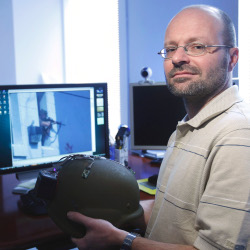Communications of the ACM
Sensor Network Turns Soldiers' Helmets Into Sniper Location System
Imagine a platoon of soldiers fighting in a hazardous urban environment who carry personal digital assistants that can display the location of enemy shooters in three dimensions and accurately identify the caliber and type of weapons they are firing.
Engineers at Vanderbilt University's Institute for Software Integrated Systems (ISIS) have developed a system that can give soldiers just such an edge by turning their combat helmets into "smart nodes" in a wireless sensor network.
ISIS developed this novel technology with the support of the Defense Advanced Research Project Agency (DARPA) and the university has patented two of the system's key elements.
 Senior research scientist Akos Ledeczi holdinga kevlar helmut with the microphones and electronics attached that turn it into a "smart node" in a shooter location system. Steve Green, Vanderbilt University Senior research scientist Akos Ledeczi holdinga kevlar helmut with the microphones and electronics attached that turn it into a "smart node" in a shooter location system. Steve Green, Vanderbilt University |
By contrast, the ISIS system combines information from a number of nodes to triangulate on shooter positions and improve the accuracy of its location identification process. It also uses a patented technique to filter out the echoes that can throw off other acoustic detection systems, explains Akos Ledeczi, the senior research scientist at ISIS who heads up the development effort.
"When DARPA gave us the assignment of creating a shooter location system using nodes with very limited capabilities, they didn't think we could solve the technical problems," Ledeczi admits. "At first, I didn't think we could do it either, but we figured out how to make it work!"
Retired U.S. Army Lieutenant Colonel Albert Sciarretta, who assesses new military technologies in urban environments for DARPA, is one of the experts who is impressed by the ISIS system: "It's strong points are that it isn't limited to locating shots fired in direct line-of-sight, it can pick up multiple shooters at the same time, and it can identify the caliber and type of weapon that is being fired."
Sciarretta adds, "A leader can use the information that this system provides to react tactically to enemy shooters in ways that limit the number of friendly force and non-combatant casualties. The ISIS system could be easily developed into an operational war-fighting system."
When a high-powered rifle is fired, it produces two different kinds of sound waves. One is the "muzzle blast" that expands outward in a spherical wave from the muzzle. The second is a conical shock wave that is produced by the bullet as it travels at supersonic speeds. Each node of the shooter location system contains an array of four sensitive microphones. If at least three of the microphones in a single node detect the muzzle blast, the information allows the nodes' microprocessor to calculate the direction that the sound came from. If the same array also detects the arrival time and angle of the bullet shockwave, a simple calculation gives the shooter's location.
"Because the microphones on the helmet are so close together, the precision is not very high," Ledeczi says. "However, the nodes are continuously exchanging the times and angles of arrival for these acoustic signals, along with their own locations and orientations. When two or more nodes detect the shot, they can provide the bearing with better than one degree accuracy. The range is typically within a few meters even from as far as 300 meters. The more sensors that pick up the shot, the more accurate the localization."
The ISIS system communicates its findings with the personal digital assistants that the soldiers carry. The PDAs are loaded with maps or overhead pictures of the area upon which the shooter locations are displayed.
In 2006, a team from the National Institute of Standards and Technology at the U.S. Army Aberdeen Test Center independently determined the accuracy of the system. Firing positions were located at distances of 50 to 300 meters from a 10-node sensor network. Six different weapons were used. The only shots that the system sometimes failed to track accurately were those that passed to one side of all of the nodes.
The field tests demonstrated that the system can pick out the location of high-powered sniper rifles even when they are firing at the same time as a submachine gun like the AK-47. They also proved that it can identify the window that a rifle is firing through even when the rifle is completely inside the building, the technique preferred by trained snipers.
These tests were performed with sensors in fixed locations. One of the problems with using a mobile network has been keeping track of the positions of the mobile nodes with sufficient precision. Standard GPS locations are not precise enough for this purpose and satellite coverage can be spotty in urban environments. The ISIS team has recently solved this problem by adding an inexpensive radio chip that allows them to track the relative position of nodes using high-precision radio interferometry. The university has patented the technique that ISIS developed.
The ISIS shooter system uses wireless nodes invented at UC Berkeley and produced by Crossbow Technology Inc. of San Jose, Calif. These smart nodes, or motes, form self-organizing wireless-sensor networks and are the realization of the Pentagon's "smart-dust" concept of radically reducing the size and cost of sensor networks for military applications. Current commercial shooter location systems are extremely expensive, with prices ranging from $10,000 to $50,000 per unit. By contrast, an entire node for the ISIS system weighs only slightly more than the four AA batteries that power it and costs about $1,000 to construct using currently available commercial hardware.
A multimedia version of this story is available on Exploration, Vanderbilt’s online research magazine.
No entries found